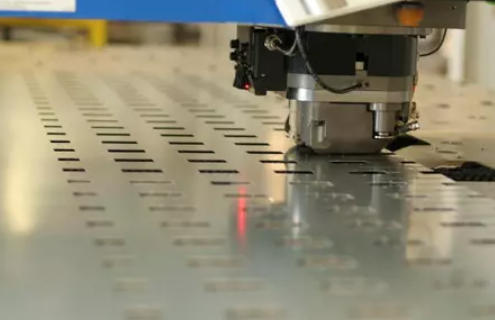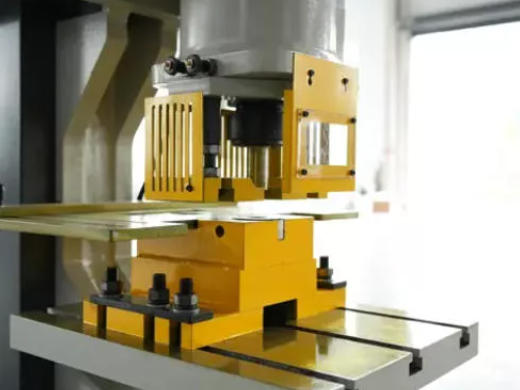Views: 222 Author: Rebecca Publish Time: 2025-11-14 Origin: Site









Content Menu
● How Punch Press Machines Work
● Core Benefits for Tableware Manufacturing
>> Unprecedented Throughput and Speed
>> Waste Reduction and Cost Efficiency
>> Versatility with Different Materials and Forms
● Key Applications in Tableware Production
>> Lids, Trays, and Panel Products
>> Thin and Deep Drawn Components
>> Custom Tableware and OEM Solutions
● Workflow Integration in Modern Tableware Factories
>> Fully Automated Production Lines
>> Real-Time Monitoring and Predictive Maintenance
>> Example: Stainless Steel Tableware Production
● Technological Innovations Shaping the Industry
>> CNC and Turret Punch Presses
>> Servo vs. Hydraulic Systems
>> Integration With Robotics and Smart Factories
● Broader Applications and Cross-Industry Insights
● Ergonomics and Workforce Transformation
● Frequently Asked Questions (FAQs)
>> 1. How does a punch press differ from a hydraulic press?
>> 2. What materials can punch press machines process in tableware factories?
>> 3. How do CNC punch presses help boost productivity?
>> 4. What safety features are integrated in advanced punch press machines?
>> 5. How does automated feeding and sorting impact tableware factory efficiency?
Punch press machines have revolutionized how tableware manufacturers approach production, turning once labor-intensive workflows into high-speed, automated, and cost-effective operations. Leveraging advanced mechanics, computer-aided controls, and integration with smart automation, punch presses enable the mass production of high-quality kitchenware products with remarkable efficiency.

In the fiercely competitive world of tableware production, productivity, precision, and cost reduction stand as industry cornerstones. The demand for consistent, scalable, and aesthetically flawless products like stainless steel cutlery, dinner plates, cookware lids, and more, necessitates robust solutions that traditional manual methods cannot fulfill. Punch press machines rise as the “heart” of modern metalworking factories, supporting global brands in responding to dynamic market needs.
A punch press is a mechanical or hydraulic machine that shapes, cuts, or forms sheet metal into specific parts by forcing a die or tool through the material. The basic workflow involves:
- Feeding sheet metal automatically onto the die bed.
- Operating a punch head driven by mechanical, hydraulic, or servo-electric systems to perform pre-programmed strikes.
- Removing waste and sorting the finished product for subsequent processes.
High-speed punch presses excel in repetitive tasks such as blanking, piercing, embossing, and forming, crucial for creating thousands of identical utensils, pot lids, trays, and panels with unmatched speed.
Modern punch presses often incorporate Computer Numerical Control (CNC) and servo drive technology, further enhancing:
- Programming flexibility for fast design changes.
- Automated tool switching for different functions in a single run.
- Smart sensors and machine analytics for predictive maintenance and error reduction.
Today's punch press machines can achieve up to 600–900 strokes per minute, resulting in the production of thousands of kitchenware parts per shift. Automated sheet feeding and robotic sorting minimize human intervention, ensuring production lines operate seamlessly for extended hours.
Precision is non-negotiable in mass-produced tableware. CNC punch presses deliver tight dimensional tolerances and burr-free edges, allowing each part to fit perfectly in downstream assembly lines or together as final customer products. This degree of accuracy greatly reduces scrap rates and the need for secondary machining.
Automated punch presses minimize both labor costs and material wastage. Features such as:
- Real-time process monitoring.
- Energy-saving servo motors.
- Tooling optimization and automatic die changeovers.
All these factors contribute to higher yields, efficient use of raw materials, and less downtime, resulting in lower total operational costs.
Tableware manufacturers frequently work with various metals such as stainless steel, aluminum, and alloys. Punch presses are engineered for rapid transitions between thicknesses and material types. Whether fabricating heavy-duty soup ladles or delicate serving spoons, machines adapt quickly with minimal changeover times, supporting both bulk and custom production.

Punch presses are vital for creating blanks for items such as spoons, forks, knives, and specialty kitchen tools. Multiple patterns can be stamped in a single setup, allowing for rapid change between product designs or OEM customer requirements.
Many cookware items, such as pot lids and serving trays, require flawless symmetry and smooth edges to ensure safety and aesthetics. High-speed punch presses not only stamp out the perfect shape but can also emboss branding or decorative patterns directly onto metal surfaces.
Certain tableware items, like mixing bowls and deep containers, combine punching and forming. Servo-driven or hydraulic punch presses offer ample flexibility to tackle both shallow and deep-formed shapes, increasing the range of kitchenware a single production cell can deliver.
Punch presses support small and large batch production—ideal for companies catering to fast-evolving hospitality trends, brand collaborations, or customized product launches. Turret-style CNC punch machines, in particular, are designed for high-mix, low-volume production cycles, keeping pace with international demands.
- Servo-driven feeders accurately align and advance sheet material.
- Automated presses perform multiple operations—punching, embossing, slotting, bending—without manual reset.
- Robots and conveyors sort, stack, and transport finished goods to polishing, edge-beading, or packaging stations.
Sensors constantly monitor machine health—tracking cycle counts, tool wear, and lubrication needs. Smart analytics platforms help forecast maintenance requirements before failures occur, enabling higher uptime and reduced unplanned stoppages.
A typical workflow might begin with stainless steel sheets loaded onto the punch press. The machine automatically positions, punches, and blanks out the product shape before transferring it to beading machines, polishers, and eventually packaging. Every phase is tracked via computer systems for quality control and traceability.
CNC turret punch presses combine rapid tool changes with programmable paths, enabling:
- Quick transitions between different shapes, patterns, or languages for international market needs.
- Batch-size flexibility, from single prototypes to multi-thousand part runs.
- Reduced cost and lead time compared to traditional die production.
- Servo-driven models offer high speed, low noise, and reduced energy consumption—ideal for continuous operation.
- Hydraulic punch presses excel in applications that demand high tonnage or deep forming, bringing flexibility for a variety of cookware and serving dish types.
Next-generation facilities integrate punch presses with robotic loaders, stackers, and AGVs (Automated Guided Vehicles) for uninterrupted production flow. Combined with MES (Manufacturing Execution System) or ERP platforms, plant managers can monitor productivity, quality, and resource consumption in real time.
While the tableware sector remains a primary beneficiary, punch press machines are foundational across industries such as:
- Automotive (chassis, panels, frames)
- Electronics (enclosures, brackets)
- Appliances (metal casings, internal frames)
- Construction (beams, structural elements)
- Packaging (custom containers, display stands)
The wide applicability of punch presses underscores their engineering versatility and technology leadership in global fabrication markets.
Automation not only improves safety—with features like enclosures, light curtains, and emergency stops—but also transforms the role of human operators. Staff now oversee programming, parts inspection, and continuous process improvement, rather than conducting physically demanding, repetitive tasks. This shift enhances workplace safety, reduces ergonomics-related injuries, and boosts job satisfaction.
Modern punch presses align with sustainability goals by maximizing material yield, using energy only during active cycles (with servo motors), and generating less scrap for recycling. Efficient layouts reduce factory footprints and lower heating/cooling needs, supporting factories in meeting green manufacturing standards.
As digitalization accelerates, punch presses are evolving with features such as:
- IoT connectivity for remote monitoring and automatic reporting.
- AI-assisted setup, adjustment, and quality inspection.
- Improved die materials and quick-change tooling for minimized downtime.
- Enhanced integration with cloud-based platforms and smart supply chains.
Manufacturers who adopt these innovations will strengthen competitiveness, shorten delivery cycles, and respond agilely to global market shifts.
Punch press machines are transformative assets in the tableware manufacturing sector, providing unparalleled speed, accuracy, and process automation. They allow brands to produce vast quantities of high-quality products at lower costs, enable rapid market adaptation through flexible programming and quick tool changes, and create safer, more ergonomic workplaces. Their integration with advanced automation, robotics, and digital platforms ensures sustained relevance for the future of global kitchenware production. Companies that invest in smart punch press solutions solidify their position as industry leaders—capable of meeting the world's rising demand for durable, attractive, and affordable tableware.

Punch presses use mechanical or servo-driven force for high-speed punching and cutting, best for repetitive, high-throughput production. Hydraulic presses apply gradual, controlled force suitable for deep forming and thicker materials, often used in larger cookware or custom shapes.
They accommodate metals such as stainless steel, aluminum, copper, and special alloys, allowing flexible production of a wide range of kitchenware items and thicknesses.
CNC punch presses automate pattern setup, enable rapid changeovers for new designs, and maintain consistent quality across long production runs, reducing downtime and errors.
Modern machines feature safety shields, interlocks, emergency stop systems, light curtains, and ergonomic designs that minimize operator risk and physical strain.
Fully automated feeding, punching, and sorting systems reduce manual handling, speed up material flow, ensure precision, and consistently deliver high-quality products—supporting scalable and efficient plant operation.
Why The Right Punch Press Machine Is Crucial for High-Quality Tableware Production?
Punch Press Machines: The Backbone of Efficient Cutlery Production
How To Choose Between Manual And Automatic Punch Press Machines?
Best Punch Press Machines for Small And Large-Scale Manufacturers
Top Manufacturers of Punch Press Machines for The Tableware Industry
What Are The Key Benefits of Investing in A Punch Press Machine for Your Factory?
How Punch Press Machines Are Revolutionizing The Cutlery Industry?
The Role of Punch Press Machines in Modern Kitchenware Production Lines
Punch Press Machine Vs. Turret Punch Press: What's The Difference?
